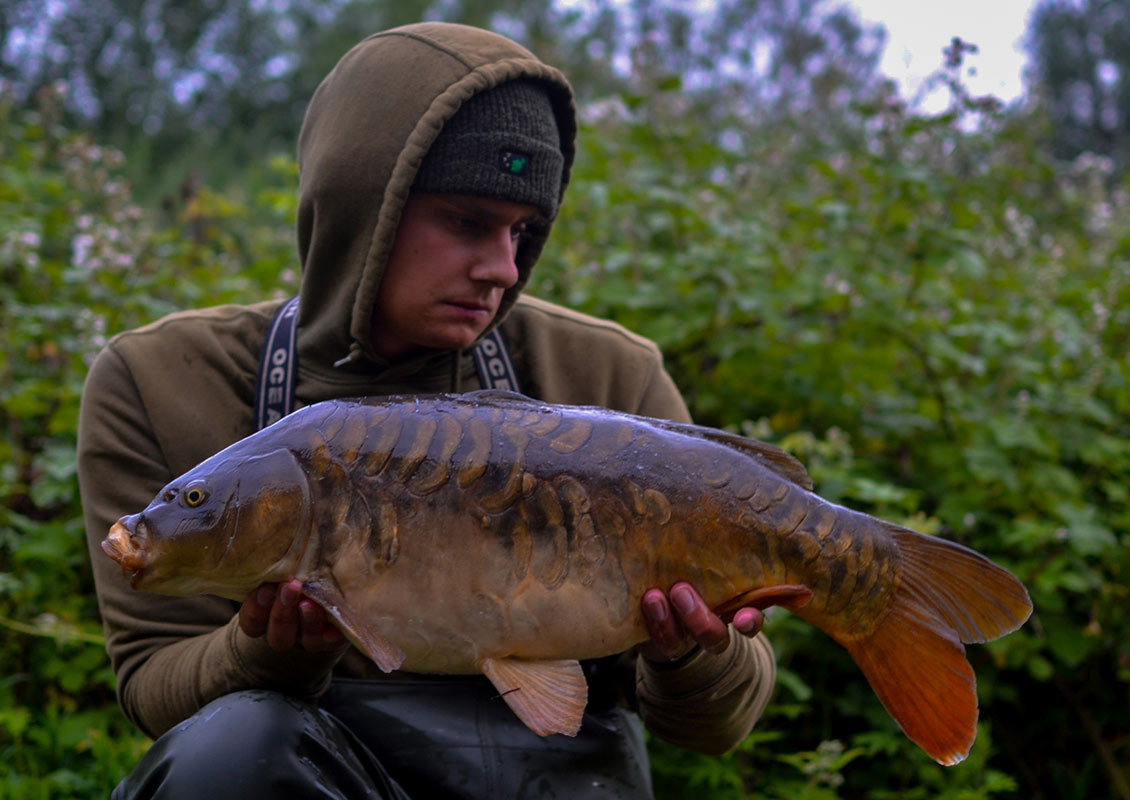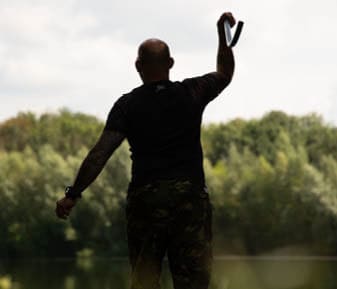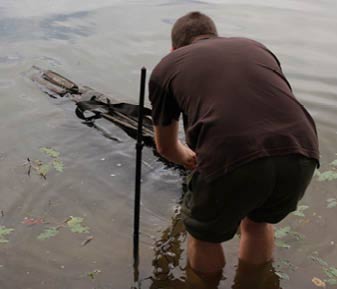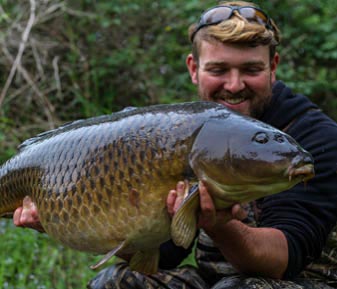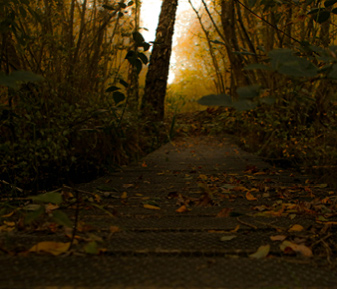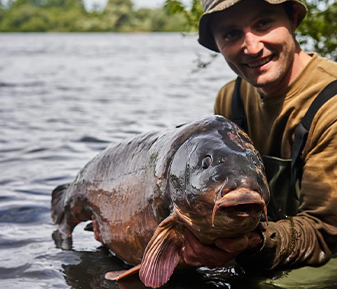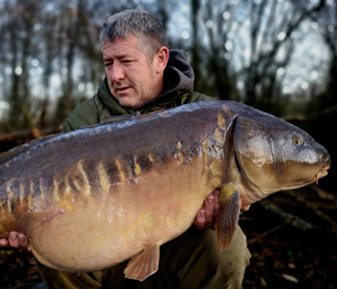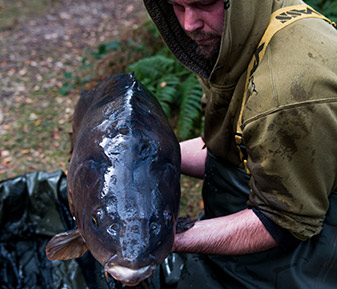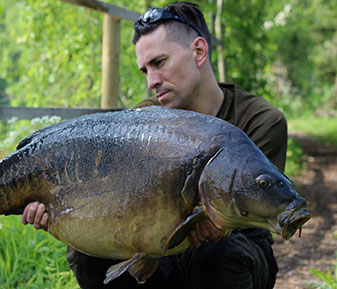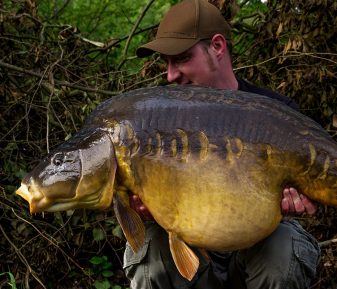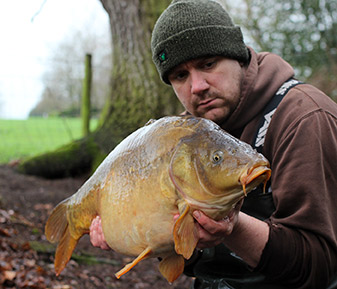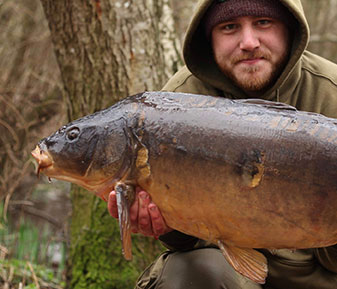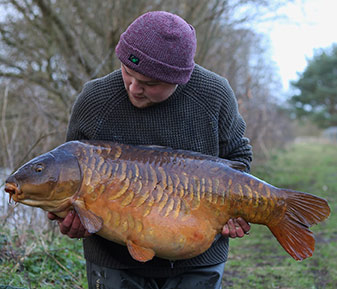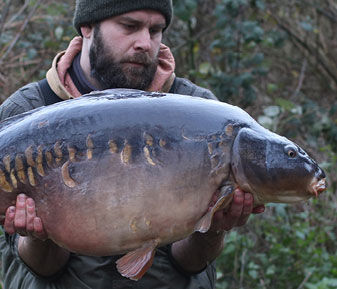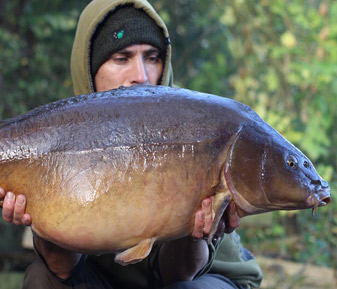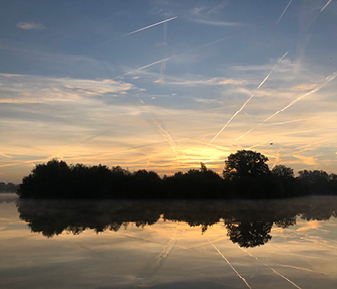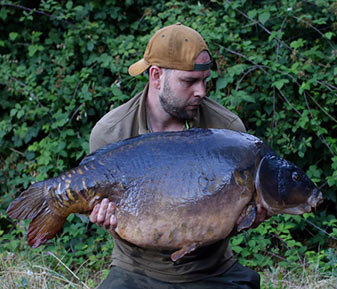Davy Claus relays a tale of when unrelenting persistence and flexibility in his angling paid off.
Lukas Hughes – Summer Nights on Apps Court
26th November 2019
Lukas Hughes explains how periods of observation and changes of approach finally brought success on a new water.
“It was June 1st and I stood looking over my lake for the summer, ticket in hand. I opted not to fish the first two weeks. Instead, I chose to just observe and take notes. I was aware that a lot of the resident fish were elusive and didn’t grace anglers’ nets regularly. During that first fortnight, I watched early mornings and late evenings, hoping to get some clues. A pattern started to emerge and I saw fish moving off a bar and into the deep water, giving a little display as they did so. Late morning they’d soiree around the bays, but would also be in the area of the bar. The venue had a total of 25 anglers on for the year. They were a nice bunch of guys and everyone left everyone else to get on with their own stuff; there was no ‘covering your tracks’ as I’ve experienced with some club tickets down the years.
After that initial period of observation, I settled into a swim which commanded a nice margin and an open-water spot. I’d already started to bait up on a spot close in with crumbed Black Seal boilies and crushed nuts. The idea was to harvest the spot, so to speak, before I fished it. My ‘harvest’ technique involved feeding smaller items in an effort to see the spot cleaned back to silty gravel. Before each period of baiting, I cast a pronged lead to the zone, before slowly pulling it back and then checking it for silkweed and debris. The lake was 90 percent silkweed, which made presentation difficult. I feel the best way to overcome this, is to harvest the spot. After a few weeks’ baiting, the drop was starting to get harder. As time went on, when I pulled my lead back, it was clearer and I began to feel the taps from gravel – the best sign you’ll get. As my first session drew near, I baited mostly with boilies, along with a little maize, given that the spot had been cleared.
I opted to kick things off with a 48-hour session and see how things panned out, as a lot of anglers were putting substantial time and effort in on the lake without success. Early Friday morning saw me doing a few laps in an effort to locate the fish on their usual routes. Banking on them dropping down into the deeper water, I chose to fish the baited swim. I waited until midday to get my rods out, not wanting to spook them from the zone. Come 11 a.m. I was set up and had tested my rigs in the margin. I chose a custom Blowback Rig with an 18mm hard hooker and a 14mm white pop-up – the presentation balanced in favour of the hard hooker was an effort to deter nuisance species.
The bait sat perfectly in the margin, clipped onto my heli-style set-up comprising 22lb mainline braid tied to a 25lb fluorocarbon leader by means of a Mahin Knot. The water was quite clear and I wanted to keep everything as inconspicuous as I could. I placed one bait on the open-water spot at around 40 yards, with the line ultra-slack, in an effort once again, to keep everything hidden from the fishes’ view. Once my foam had popped up, I put out four Spombs of boilies and maize.
On the other rod I went for a ‘washing line’ approach. I kept all the line out of the water apart from the last eight feet of fluorocarbon leader, looking to be covert, but accurate. I opted for this method as I’d seen the fish visiting this spot when I was baiting up and knew that they would ‘flank’ repeatedly to check for rigs. The line was out of the water for some eight yards or so up the margin and secured to a storm pole by means of an elastic band. I set everything up by wading up the margin with a bare lead to the storm pole. At the pole, I then clipped my rig on and lowered in place. Once again, after the foam had popped up from the hook, I gave the area a light spread of bait. With everything in place, I tightened my line on the spool and checked that the elastic band was set so it would release on a take – when using this set-up, I’d advocate always using heavy bobbins so your alarms correctly signal a take.
With both rods set, I sat in anticipation. I retreated to the brolly soon after however, in an effort to avoid the heat of a summer’s day and to tie a few rigs and leaders, just in case a quick change was needed during the night. It’s always best to be ready for such eventualities and the preparation obviously saves time when getting rigs back out in the hours of darkness. With a pal of mine for company for the evening, I lit the barbecue and we enjoyed pork belly roll and apple sauce, washed down with a couple of Red Stripes. I also had Nellie, my pug, for company as my friend and I sat chatting about our fishing experiences. Then, at around 8 p.m. my Neville screamed off… it was my right-hand rod with the washing-line set-up. The carp that had taken my carefully presented bait then had my rod bending as it took line and headed for deeper water. Some five minutes later, the fish was looking to get down the left-hand margin and into the reeds. After slipping on my waders, I could see from where I stood in the water, that the fish was trying to get to a submerged metal pole. A further five minutes later though, I’d managed to turn the fish and she popped up around ten feet out. Over the net cord she went and I had a nice mirror to start my campaign.
After unhooking her, I let her rest while I prepared the scales. The weighing complete, and with a few photos taken she was soon back in the lake swimming away, none the worse for her ordeal. The rest of the session was quiet and the fish turned out to be the only one to come out over the weekend, or indeed, the following week.
Over the next few weeks, I kept the bait going in. When pre-baiting, the most important thing is consistency, the aim being to get the carp to regard your bait as a safe food source, and for them also to regard the area as somewhere they feel comfortable in. Carp will remember the bait when you introduce it again during your carp fishing session – well, that’s what we hope!
My next session was an overnighter and I arrived surprised to see the lake devoid of anglers. After a lap or two I decided to fish the baited area again, looking to fish the same way as in my first session, given my success. Everything was going well and at around 7p.m. the water came alive with carp. One after another fish showed themselves, with a few of them doing so over my spot. As it got dark I thought my luck would be in, but it turned out to be a very quiet night, apart from the noise of some local fireworks. Surprised by the lack of response, I spoke with Si, a bailiff, and he told me that when they show as I’d seen them, no one has a bite – this was a feature of the lake that caused a few people to question their ability. Nonetheless, before leaving I introduced some more bait, putting quite a bit on the spot with a plan to fish it again two days later.
I got to the lake after work to find a few anglers fishing at the car park end, so once again, I opted for the baited swim. Arriving at my chosen pitch, I could feel the warmth of the wind blowing into my margin. I normally fish on the wind if it feels warm, but not if it’s cold – as it is often is in the winter months – unless I see anything to persuade me otherwise. My approach on this occasion involved fishing wafters on 25lb Recoil D-rigs over boilies, One of the rods went into open water with 50 or so baits over the top, whilst for the margin rod, I introduced a handful of chopped boilies and nuts. Within an hour, I had a take on my open-water rod, but it turned out to be a small common of around five pounds. I made a quick call and a bailiff arrived soon after to move it to the stock pond. The lake was in a transition period and smaller fish were being taken out; a few pike had also been introduced in an effort to thin fish out a little and to re-establish a balanced food pyramid.
It was just getting dark as I reset the rod and in the failing light, birds called for the final time that day. Sitting with a coffee and waiting to hear any shows or activity, my rod went again. By the time I got to it, the clutch was screaming; it was a powerful fish and it took at least 60 yards of line before I regained any sort of control. The battle went on for about ten minutes before the fish’s tail slapped on the surface. Once more it stripped me of a lot of line and as I got the upper hand again, I played it gingerly, feeling it could be one of the lake’s gems. Shining my torch at the line, I could make out my leader knot just above the water and as I walked backwards slowly, a huge mouth appeared. As it transpired however, the mouth in question belonged to a forty-pound catfish – I didn’t know the water held them until then, but I established that a few remained after a removal programme. After unhooking it, I slipped it straight back.
The catfish had ruined my leader; it was corkscrewed and absolutely covered in slime, so on went a freshly tied one and back out went the rod. The rest of the night passed quietly once again and I awoke around 6 a.m. to start packing down with the sun creeping above the trees. Nothing else happened that morning and it was back to the drawing board…
The fish in the lake were obviously very smart when it came to rigs and baits – despite their young age. After baiting a few more times, I introduced some in a margin near the out-of-bounds bay, watching fish flank over it aggressively, often moving it a good few feet before eating it. These little things you notice can go a long way and I so I concluded that on my next session, I had to fish Hinged Soft Rigs around eight inches long Made up from Thinking anglers end tackle. There are huge advantages to be gained on a new lake from just watching; you can learn so much… even the habits of each fish.
The next session drew closer and I was itching to get down there. When I arrived, the wind was blowing from the same direction again. A bailiff advised that one or two fish had come out that weekend – a good sign – and fish had also showed around my zone. I set up quickly and soon had everything ready to go. On this occasion I fished two rods in open water with the same braid-to-fluoro set-up, but with Hinged Soft Rigs. Hookbait-wise I went for two matching pop-ups, boosted with Belachan and GLM powder. The rods went out smoothly with a nice drop. After the foam had popped up, I sprayed around 60 baits over the top – I find generally, that this number is just enough to draw them in for a bite on an overnighter. My friend arrived for another barbecue and we sat back enjoying a lovely warm evening not always typical of a British summer. The night drew in and given the cloud cover that was keeping the air temperature up, I slept outside.
I awoke around 5 a.m. to the sound of my clutch ticking away. Getting out of my bag quickly, the fish kited left as I lifted the rod from its rests. As it made towards the bay, on went my waders and after a short battle, she was in the net. Just as I unhooked her, a bailiff arrived. I showed him the fish and it was one he’d not seen before: a lovely common with a small tail. He then rattled off a few photos for me and I slipped her back. After quickly packing down, I headed off to work a happy man… my change of tactics had worked after I’d spent a few hours watching them feed in the edge.
We were well into summer by this time and the lake had fallen foul of a big algae bloom. As a result, I decided to just bait for a time, rather than fish. Most of the members had pulled off having struggled. I’d had two decent fish and a few smaller ones that were moved to the stock pond, plus of course, the catfish. I think some anglers thought the venue would be far easier, given the fishes’ young age and the amount of bait that was going in. A lot of them weren’t checking their spots however, or watching them in the edge to see how they fed.
A few weeks on, I’d continued with my light baiting twice each week in an effort to keep them interested. My next session fell during a wet spell, courtesy of a random low-pressure system. This I couldn’t ignore ignore as my spot was in slightly deeper water. Arriving at the lake I found the top end was very busy, given that a few good fish had been seen up there. I knew the weather was going to change however, so set up in the swim I’d baited. I was preparing everything under my brolly and watched the clouds gathering as the wind speed increased. Soon I had both rods out in open water, having chosen to go with the same tactics as before when I landed the common. As I headed back to my brolly, the first rod was away and a tussle of no more than thirty seconds or so was followed by another small fish being transferred to the stock pond. A short while later I banked a catfish of ten pounds or so.
After this flurry of activity and with my rods reset, I sat in readiness once again, listening to the wind. Darkness saw no fish come to my net, but a guy two swims up asked me to do some photos of a fish he’d caught in the early hours. Afterwards, I went back to sleep, tired from lost sleep due to the noise of the wind.
Nothing else happened during the remainder of the morning, but I knew they were on me. I changed to white pop-ups, looking to bring a bite, switching from baits that matched my free offerings. The rods went out with a scattering of boilies of mixed sizes in an effort to keep the carp guessing. The weather was deteriorating further, but fish were topping over my spot; surely it was only a matter of time…
My Hinged Soft Rig-style set-up comprised of tungskin, attached to Recoil by means of an Albright Knot. The stiff section was doubled over Multi Rig-style, with size 4 TA Chod hook secured in place by a small piece of silicone through the hook eye. I like this rig, not only for its effectiveness over both clean and choddy bottoms, but also for how quickly you can change the hook.
That evening was quiet once again. It’s rare to get bites at dusk on the venue, but the fish were showing – as mentioned earlier though, such activity doesn’t necessarily result in takes. I had a number of liners during the night however, and around 6 a.m. my left-hand rod went. This fish plodded as I tussled with it, but then stayed deep once it was close in. With it comfortably netted, I checked straight away and found that it was one of the fish I was after: a linear that hadn’t been caught for a good few years. This was a right result! The rig had performed well – normal hook-holds are smack-bang in the bottom lip. I decided not to put the rod back out as I was leaving in the morning and didn’t want to spook anything off the spot.
I gave a mate a quick call, asking if he’d come and do some photos for me. I then started to pack up and as I grabbed my pegs that I use for wrapping, my last rod was away. The fish was taking a lot of line, but I regained most after its initial run, before it then darted into my left-hand margin. I could feel it on the pole, so quickly jumped into my waders. Disaster averted, after a few minutes, the fish was safely in the net. With both fish in the net, my friend turned up to take the photos. There were so few people on, they’d all heard the commotion and some came round to see the fish as we shot the pictures. Both were then safely returned and I headed to work.
Given the severity of the algae bloom, water samples were taken and the decision was made to close the lake for a time. Two aerators were installed that would run constantly in an effort to Help the issue. I went on to fish once more, but without success. I checked the spot after baiting, but it had seemingly blown. I’d not heard of any fish coming out and I was busy elsewhere with a social trip, so decided to call it a day. I aim though, to go back early next spring, given that I have plans to fish another water through the winter. The summer I had on Apps saw me reach double figures and land a few nice fish – good going for this year. When I do return, I plan to attack it with Zigs and hopefully catch some of the other gems…









